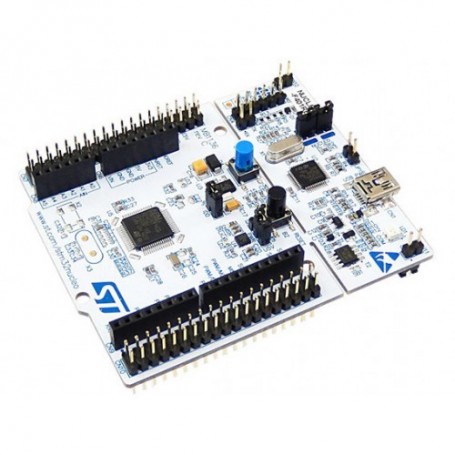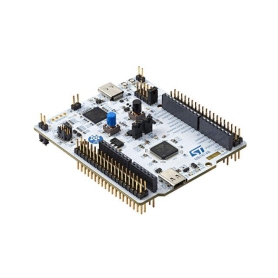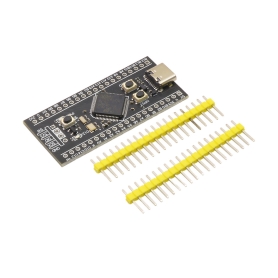
برد NUCLEO-64 STM32F411RE با پشتیبانی از آردوینو
برد NUCLEO-64 از سری تولیدات شرکت ST علاوه بر دارا بودن استاندارد پایه های آردوینو به منظور سازگاری با انواع شیلد های آردوینو، دارای پروگرام JTAG بر روی خود برد به همراه خروجی دیجیتال دیگر پایه های میکروکنترلر می باشد
- دیدگاه کاربران 5 دیدگاه
معرفی
بردهای دیسکاوری STM32 بردهای ارزان بوده و به عنوان روشهای جامعی برای سنجش قابلیتهای برجسته میکروکنترلرهای سری STM32 شناخته می شوند. این برد ها به دلیل ویژگیهای کاربری آسان و چند منظوره بودن برای طیف وسیعی از کاربرهای مبتدی تا حرفهای مناسب می باشد.
این بردها زیر بنای لازم برای نمایان نمودن ویژگیهای دستگاههای خاص را فراهم مینماید بدین ترتیب که با استفاده از مثالهای نرم افزاری جامع ارئه شده آن میتوان از ویژگیهای دستگاه و سخت افزارهای جانبی اضافه شده به آن بهره مند شد. همچنین با استفاده از کانکتورهای درنظرگرفته شده برای آن می توان به ورودی و خروجیهای (I/0s) دستگاه و سخت افزارجانبی اضافه شده دسترسی داشت.
بردهای STM32 Discovery به کمک پروگرمر و برنامه اشکال زدا (debugger) مجموعه ایده آلی برای نمونه سازی محصولات می باشند.
The Nucleo F411RE board features an ARM Cortex-M4 based STM32F411RE MCU with a wide range of connectivity support and configurations. Here are some highlights of the Nucleo F411RE board:
- STM32 microcontroller in QFP64 package
- Two types of extension resources:
- Arduino Uno V3 connectivity
- ST morpho extension pin headers for full access to all STM32 I/Os
- On-board ST-LINK/V2-1 debugger/programmer with SWD connector
- Flexible board power supply:
- USB VBUS or external source(3.3V, 5V, 7 - 12V)
- Power management access point
- Three LEDs: USB communication (LD1), user LED (LD2), power LED (LD3)
- Two push-buttons: USER and RESET
Hardware
Nucleo F411RE provides the following hardware components:
- STM32F411RET6 in LQFP64 package
- ARM® 32-bit Cortex®-M4 CPU with FPU
- 100 MHz max CPU frequency
- VDD from 1.7 V to 3.6 V
- 512 KB Flash
- 128 KB SRAM
- GPIO with external interrupt capability
- 12-bit ADC with 16 channels, with FIFO and burst support
- RTC
- 8 General purpose timers
- 2 watchdog timers (independent and window)
- SysTick timer
- USART/UART (3)
- I2C (3)
- SPI (5)
- SDIO
- USB 2.0 OTG FS
- DMA Controller
- CRC calculation unit
Supported Features
The Zephyr nucleo_f411re board configuration supports the following hardware features:
| Interface | Controller | Driver/Component |
|---|---|---|
| NVIC | on-chip | nested vector interrupt controller |
| UART | on-chip | serial port |
| PINMUX | on-chip | pinmux |
| GPIO | on-chip | gpio |
| PWM | on-chip | pwm |
| I2C | on-chip | i2c |
Other hardware features are not yet supported on this Zephyr port.
The default configuration can be found in the defconfig file: boards/arm/nucleo_f411re/nucleo_f411re_defconfig
Connections and IOs
Nucleo F411RE Board has 8 GPIO controllers. These controllers are responsible for pin muxing, input/output, pull-up, etc.
Default Zephyr Peripheral Mapping:
- UART_1_TX : PB6
- UART_1_RX : PB7
- UART_2_TX : PA2
- UART_2_RX : PA3
- PWM_2_CH1 : PA0
- USER_PB : PC13
- LD2 : PA5
- I2C1_SDA : PB9
- I2C1_SCL : PB8
- I2C2_SDA : PB3
- I2C2_SCL : PB10
- I2C3_SDA : PB4
- I2C3_SCL : PA8
System Clock
Nucleo F411RE System Clock could be driven by internal or external oscillator, as well as main PLL clock. By default System clock is driven by PLL clock at 84MHz, driven by 8MHz high speed external clock.
Serial Port
Nucleo F411RE board has 3 UARTs. The Zephyr console output is assigned to UART2. Default settings are 115200 8N1.
Programming and Debugging
Applications for the nucleo_f411re board configuration can be built and flashed in the usual way
Flashing
Nucleo F411RE board includes an ST-LINK/V2-1 embedded debug tool interface. This interface is supported by the openocd version included in Zephyr SDK.
Flashing an application to Nucleo F411RE
Run a serial host program to connect with your Nucleo board.
$ minicom -D /dev/ttyACM0
Build and flash the application:
# On Linux/macOS
cd $ZEPHYR_BASE/samples/hello_world
mkdir build && cd build
# On Windows
cd %ZEPHYR_BASE%sampleshello_world
mkdir build & cd build
# Use cmake to configure a Ninja-based build system:
cmake -GNinja -DBOARD=nucleo_f411re ..
# Now run ninja on the generated build system:
ninja
ninja flash
You should see the following message on the console:
$ Hello World! arm
Debugging
You can debug an application in the usual way.
# On Linux/macOS
cd $ZEPHYR_BASE/samples/hello_world
# If you already made a build directory (build) and ran cmake, just 'cd build' instead.
mkdir build && cd build
# On Windows
cd %ZEPHYR_BASE%sampleshello_world
# If you already made a build directory (build) and ran cmake, just 'cd build' instead.
mkdir build & cd build
# If you already made a build directory (build) and ran cmake, just 'cd build' instead.
# Use cmake to configure a Ninja-based build system:
cmake -GNinja -DBOARD=nucleo_f411re ..
# Now run ninja on the generated build system:
ninja debug

-
وحید مهینی | 3 سال پیش کی موجود میشه؟ یا اصلا نمیشه؟ -
بابک محمدی زاده | 4 سال پیش سلام لطفا موجود کنید خواهشا -
sadra keyvani | 6 سال پیش سلام موجود نمیشه؟



















